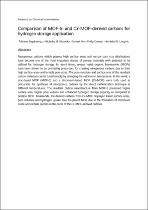 ResearchSpace
ResearchSpace
Comparison of MOF-5- and Cr-MOF-derived carbons for hydrogen storage application
JavaScript is disabled for your browser. Some features of this site may not work without it.
- ResearchSpace
- →
- Research Publications/Outputs
- →
- Journal Articles
- →
- View Item
| dc.contributor.author |
Segakweng, T

|
|
| dc.contributor.author |
Musyoka, Nicholas M

|
|
| dc.contributor.author |
Ren, Jianwei

|
|
| dc.contributor.author |
Crouse, P

|
|
| dc.contributor.author |
Langmi, Henrietta W

|
|
| dc.date.accessioned | 2016-07-20T10:54:28Z | |
| dc.date.available | 2016-07-20T10:54:28Z | |
| dc.date.issued | 2015-11 | |
| dc.identifier.citation | Segakweng, T. Musyoka, N.M., Ren, J., Crouse, P. and Langmi, H.W. 2015. Comparison of MOF-5- and Cr-MOF-derived carbons for hydrogen storage application. Research on Chemical Intermediates, 42(5), 4951–4961 | en_US |
| dc.identifier.issn | 0922-6168 | |
| dc.identifier.uri | DOI 10.1007/s11164-015-2338-1 | |
| dc.identifier.uri | http://hdl.handle.net/10204/8642 | |
| dc.description | Copyright: 2015 Springer. Due to copyright restrictions, the attached PDF file only contains the abstract of the full text item. For access to the full text item, please consult the publisher's website. The definitive version of the work is published in Research on Chemical Intermediates, 42(5), 4951–4961 | en_US |
| dc.description.abstract | Nanoporous carbons which possess high surface areas and narrow pore size distributions have become one of the most important classes of porous materials with potential to be utilized for hydrogen storage. In recent times, several metal–organic frameworks (MOFs) have been shown to be promising precursors for creating nanoporous carbons due to their high surface areas and tunable pore sizes. The pore structure and surface area of the resultant carbon materials can be tuned simply by changing the calcination temperature. In this work, a zinc-based MOF (MOF-5) and a chromium-based MOF (Cr-MOF) were both used as precursors for syntheses of nanoporous carbons by the direct carbonization technique at different temperatures. The resultant carbon nanostructure from MOF-5 possessed higher surface area, higher pore volume and enhanced hydrogen storage capacity as compared to pristine MOF. Meanwhile, the derived carbons from Cr-MOF displayed lower surface areas, pore volumes and hydrogen uptake than the parent MOF due to the formation of chromium oxide and carbide species in the pores of the Cr-MOF-derived carbons. | en_US |
| dc.language.iso | en | en_US |
| dc.publisher | Springer | en_US |
| dc.relation.ispartofseries | Workflow;16431 | |
| dc.subject | Metal–organic framework | en_US |
| dc.subject | MOF-5 | en_US |
| dc.subject | Cr-MOF | en_US |
| dc.subject | MOF-derived carbon | en_US |
| dc.subject | Hydrogen storage | en_US |
| dc.title | Comparison of MOF-5- and Cr-MOF-derived carbons for hydrogen storage application | en_US |
| dc.type | Article | en_US |
| dc.identifier.apacitation | Segakweng, T., Musyoka, N. M., Ren, J., Crouse, P., & Langmi, H. W. (2015). Comparison of MOF-5- and Cr-MOF-derived carbons for hydrogen storage application. http://hdl.handle.net/10204/8642 | en_ZA |
| dc.identifier.chicagocitation | Segakweng, T, Nicholas M Musyoka, Jianwei Ren, P Crouse, and Henrietta W Langmi "Comparison of MOF-5- and Cr-MOF-derived carbons for hydrogen storage application." (2015) http://hdl.handle.net/10204/8642 | en_ZA |
| dc.identifier.vancouvercitation | Segakweng T, Musyoka NM, Ren J, Crouse P, Langmi HW. Comparison of MOF-5- and Cr-MOF-derived carbons for hydrogen storage application. 2015; http://hdl.handle.net/10204/8642. | en_ZA |
| dc.identifier.ris | TY - Article AU - Segakweng, T AU - Musyoka, Nicholas M AU - Ren, Jianwei AU - Crouse, P AU - Langmi, Henrietta W AB - Nanoporous carbons which possess high surface areas and narrow pore size distributions have become one of the most important classes of porous materials with potential to be utilized for hydrogen storage. In recent times, several metal–organic frameworks (MOFs) have been shown to be promising precursors for creating nanoporous carbons due to their high surface areas and tunable pore sizes. The pore structure and surface area of the resultant carbon materials can be tuned simply by changing the calcination temperature. In this work, a zinc-based MOF (MOF-5) and a chromium-based MOF (Cr-MOF) were both used as precursors for syntheses of nanoporous carbons by the direct carbonization technique at different temperatures. The resultant carbon nanostructure from MOF-5 possessed higher surface area, higher pore volume and enhanced hydrogen storage capacity as compared to pristine MOF. Meanwhile, the derived carbons from Cr-MOF displayed lower surface areas, pore volumes and hydrogen uptake than the parent MOF due to the formation of chromium oxide and carbide species in the pores of the Cr-MOF-derived carbons. DA - 2015-11 DB - ResearchSpace DP - CSIR KW - Metal–organic framework KW - MOF-5 KW - Cr-MOF KW - MOF-derived carbon KW - Hydrogen storage LK - https://researchspace.csir.co.za PY - 2015 SM - 0922-6168 T1 - Comparison of MOF-5- and Cr-MOF-derived carbons for hydrogen storage application TI - Comparison of MOF-5- and Cr-MOF-derived carbons for hydrogen storage application UR - http://hdl.handle.net/10204/8642 ER - | en_ZA |





